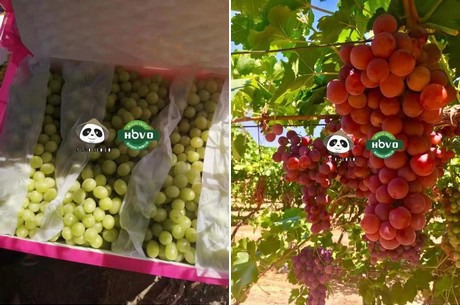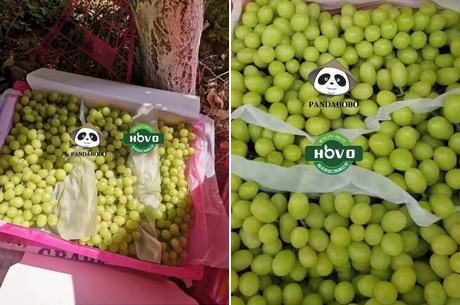This year’s grape season has been advancing smoothly. Many new varieties are becoming increasingly popular, and growers have also been adjusting their varieties following changing market trends. “There are many popular grapes in China, and there are many varieties. Customers nowadays have diversified needs. Chinese consumers, especially, pay more attention to quality and taste. At the same time, large volumes of grapes and citrus from overseas have also entered China, offering consumers even more choices.
In the past, grapes from Xijiang were very well-known, but nowadays, grapes from Japan, Australia, and other countries have also become available to Chinese consumers, contributing to lower prices. As a result, the consumption of local grapes has been declining year by year," said Zeng Minhu from Shaanxi HoVo Import & Export Co., Ltd.  White seedless and fresh red grapes from Xinjiang
White seedless and fresh red grapes from Xinjiang
“Our grapes are mainly grown in Xinjiang and Yunnan. We chose these two production areas because Xinjiang is ideal for growing grapes, while crops from Yunnan come onto the market early. The supply window begins in June and lasts until the end of October. Grapes in different regions ripen at different times, north first and then moving south. This year's production is very large, with very good quality and low prices. The core competitiveness of grapes is quality and prices. Compared with production areas in other parts of the world, the unique geographical conditions of Xinjiang bring about excellent taste, high sugar content, and a myriad of varieties.”

White seedless grapes from Xinjiang  “The price of fresh fruit this year is on the lower side. With a large stock of raisins left, farmers are not eager to dry grapes into raisins this year, driving the price of fresh fruit down. However, with cooler days in Xinjiang in sight, prices are expected to increase gradually. We export products to various countries in the Middle East and Southeast Asia such as Dubai, Bahrain, Maldives, and Bangladesh. The export performance has not been ideal in recent years, the main reasons being the rising labor costs and raw material costs in China. Export prices for Chinese products are catching up with those of developed countries."
“The price of fresh fruit this year is on the lower side. With a large stock of raisins left, farmers are not eager to dry grapes into raisins this year, driving the price of fresh fruit down. However, with cooler days in Xinjiang in sight, prices are expected to increase gradually. We export products to various countries in the Middle East and Southeast Asia such as Dubai, Bahrain, Maldives, and Bangladesh. The export performance has not been ideal in recent years, the main reasons being the rising labor costs and raw material costs in China. Export prices for Chinese products are catching up with those of developed countries."
The Chinese government has provided farmers with more investment and training programs the year to help them build a stable and quality supply, in order to find the right sales channels. According to Zeng Minhu, this is also what is needed to succeed in the Chinese market.
“We need to change the traditional growing model, save labor costs, gradually move closer to the models of Europe and America, and improve mechanized and standardized growing. The era of high-quality and low-price Chinese fruit will soon be behind us, and we are getting closer to scaled, mechanized, and standardized farming. If we depended on the manual labor of Chinese farmers, there wouldn’t be any cheap labor left in China after 10 years, and the cost would naturally rise. Apple farmers and packers in China now are all elderly people. After 10 years, they won’t be able to continue, and we will have to rely on machinery. This is an inevitable trend."  Fresh hongxing apples
Fresh hongxing apples
Shaanxi HoVo Import & Export Co., Ltd. is a large Chinese fruit and vegetable exporter. In addition to grapes, they also market fruit such as apples and mandarins. They will take part in the Asia Fruit Logistica this year and welcome their visitors at Stand O02M in Hall 5.
More information:
Contact: Zeng Minhu
Company: Shaanxi HoVo Import & Export Co., Ltd.
Email: 358551851@qq.com
